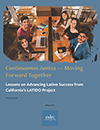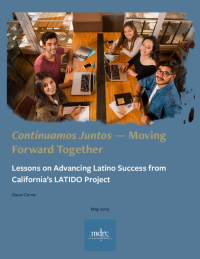Continuamos Juntos — Moving Forward Together
Lessons on Advancing Latino Success from California’s LATIDO Project

 Latinos are the fastest growing college population in California, but less than one-quarter of all Latino adults in the state earn a college degree. To reverse this trend, both the California Community Colleges Chancellor’s Office and the California State University (CSU) Office of the Chancellor launched new initiatives in 2017 to raise Latino graduation rates by 2022 and 2025, respectively. Key players in these efforts are the state’s Hispanic Serving Institutions (HSIs), which are public, degree-granting institutions that enroll the equivalent of at least 25 percent full-time Latino undergraduates in their overall student population. California has the country’s highest concentration of HSIs, with 96 of its 144 community colleges and 21 of its 23 CSU campuses. The state provides a unique perspective on the challenges and opportunities of advancing the higher education prospects of this thriving population.
Latinos are the fastest growing college population in California, but less than one-quarter of all Latino adults in the state earn a college degree. To reverse this trend, both the California Community Colleges Chancellor’s Office and the California State University (CSU) Office of the Chancellor launched new initiatives in 2017 to raise Latino graduation rates by 2022 and 2025, respectively. Key players in these efforts are the state’s Hispanic Serving Institutions (HSIs), which are public, degree-granting institutions that enroll the equivalent of at least 25 percent full-time Latino undergraduates in their overall student population. California has the country’s highest concentration of HSIs, with 96 of its 144 community colleges and 21 of its 23 CSU campuses. The state provides a unique perspective on the challenges and opportunities of advancing the higher education prospects of this thriving population.
In 2017, MDRC launched the Latino Academic Transfer and Institutional Degree Opportunities (LATIDO) study in collaboration with the community college chancellor’s office to investigate how California HSI’s are supporting undergraduate Latino students. The work began with a roundtable discussion that included scholars, policymakers, and practitioners. This led to the evaluation of Latino education programs at five HSIs: CSU Dominguez Hills, CSU Fresno, Hartnell College, Mount San Antonio College, and San Bernardino Valley College.
Through interviews with students, faculty, staff, and administrators at each college, MDRC researchers collected feedback and information on campus programs, services, and interventions that served Latino student needs. The following cross-cutting themes emerged across the colleges under study:
-
The importance of fostering a sense of belonging to smooth the transition from home to college, especially for first-generation Latino students
-
The urgent need to hire and train successful Latino students as peer leaders to help new or struggling students
-
The role that increasing connections between Latino students’ families, communities, and college circles, plays in student success
-
The overarching goal of increasing faculty diversity and cross-cultural competence among all staff
-
The imperative to scale successful programs for Latino students by establishing institution-wide strategies
These themes, and the lessons on culturally responsive approaches to Latino student success, can shape future policy and practice. In particular, California colleges should consider expanding access to Dream Centers and other spaces on campus that give students a place to socialize and obtain vital information; promote more collaboration and alignment between two- and four-year colleges to ease the transition for Latino transfer students; hire and train academically successful Latino students as institutional peer leaders; and prioritize diversity in faculty hiring, and cross-cultural competency training for all staff.






